KB Home Bundle
Who Really Controls KB Home?
In the ever-shifting real estate market, understanding the ownership structure of a major homebuilder like KB Home is paramount. Founded in 1957 as Kaufman & Broad, the company has grown to become a significant player in the U.S. housing market. Understanding the KB Home SWOT Analysis is key to understanding the company.
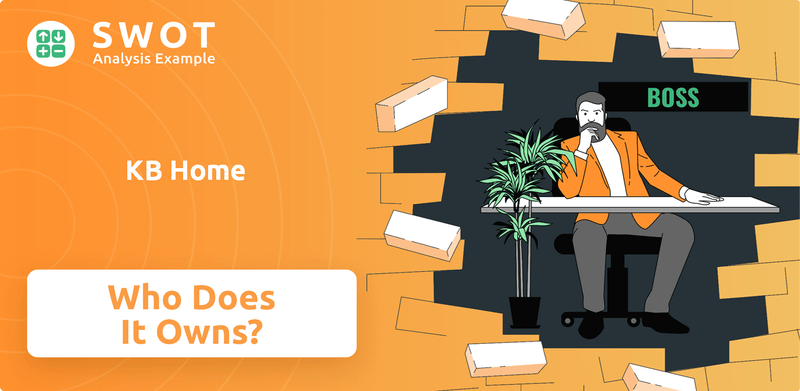
This deep dive into KB Home ownership will explore its history, from its initial public offering in 1963 to its current status as a publicly traded company. We'll examine who owns KB Home, including major shareholders and the influence of its executives and board of directors. This analysis will provide valuable insights for investors and anyone interested in the KB Home company profile and its future.
Who Founded KB Home?
The story of KB Home begins in 1957, when Donald Bruce Kaufman and Eli Broad joined forces to establish the Kaufman & Broad Building Company in Detroit, Michigan. This marked the inception of what would evolve into a major player in the homebuilding industry. Their initial focus was on providing affordable housing, a strategy that quickly gained traction in the market.
The founders began with a modest investment, relying on a $25,000 loan from Eli Broad's in-laws. This seed money fueled their initial projects, including the construction of two model homes in the Northeast Detroit suburbs. The response was immediate and substantial, with 17 homes sold in a single weekend. Within two years, the company had built 600 homes, demonstrating the early success of their business model.
In 1961, Kaufman & Broad took a significant step by going public, raising approximately $1.8 million through its initial public offering. This financial boost enabled the company to expand beyond Michigan. The expansion began in California in 1962 and 1963, and later extended internationally to France in 1967, showcasing the company's ambition and growth potential. The early ownership structure between the founders is not publicly detailed, but their vision of affordable housing and strategic expansion laid the groundwork for the company's trajectory.
The founders' early strategy was centered on providing affordable housing, which resonated with the market and fueled rapid growth. The initial public offering in 1961 was a pivotal moment, providing capital for expansion. The company's success demonstrates the importance of strategic vision and financial planning in the homebuilding sector. Learn more about the Growth Strategy of KB Home.
- The company's initial focus on affordable housing was a key factor in its early success.
- The IPO in 1961 provided the necessary capital for expansion beyond the initial market.
- Early expansion into California and France marked the beginning of KB Home's broader footprint.
- The company's early success highlights the importance of strategic vision and financial planning.
KB Home SWOT Analysis
- Complete SWOT Breakdown
- Fully Customizable
- Editable in Excel & Word
- Professional Formatting
- Investor-Ready Format
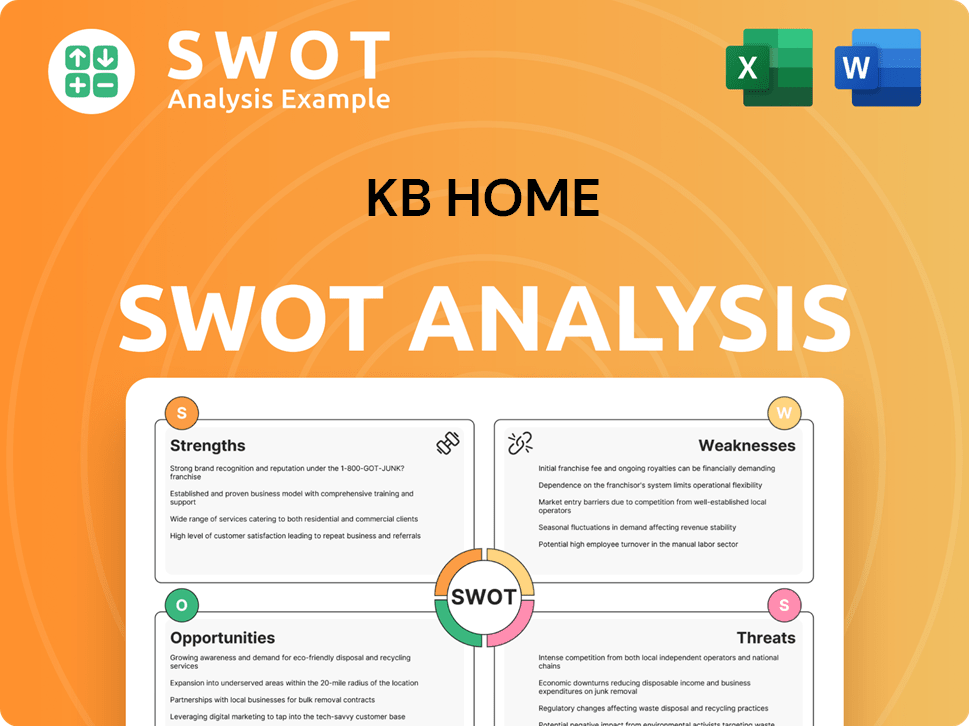
How Has KB Home’s Ownership Changed Over Time?
The ownership structure of KB Home has seen significant changes since its inception. The company went public in 1963 and listed on the New York Stock Exchange (NYSE: KBH) in 1986, marking a pivotal moment for its expansion and financial stability. As a publicly traded entity, KB Home adheres to regulations and reporting requirements set by the SEC. Understanding KB Home's brief history helps to contextualize these ownership shifts.
Currently, the ownership of KB Home is diverse, encompassing institutional investors, mutual funds, exchange-traded funds (ETFs), public companies, and individual shareholders. Data from May 31, 2024, indicates that approximately 81.43% of the company's stock is held by institutional investors, 3.57% by insiders, and 15.01% by public companies and individual investors. Key institutional shareholders include BlackRock Inc. (13.71%), Vanguard Group Inc. (9.71%), and FMR LLC (8.53%). These major investment firms and mutual funds hold considerable stakes, influencing the company's strategic direction.
| Shareholder | Percentage of Ownership (Approximate) | Type |
|---|---|---|
| BlackRock Inc. | 13.71% | Institutional Investor |
| Vanguard Group Inc. | 9.71% | Institutional Investor |
| FMR LLC | 8.53% | Institutional Investor |
In 2006, during a downturn in the housing market, KB Home received a notable investment from Cerberus Capital Management, a private equity firm, which aided in stabilizing its operations. As of December 31, 2024, the company had 72,156,821 shares outstanding, with a market value of voting common stock held by non-affiliates at $5,782,776,530. These changes in major shareholding directly impact company strategy and governance, as large institutional investors can influence management decisions. Understanding who owns KB Home is crucial for investors and stakeholders.
KB Home's ownership is primarily held by institutional investors, with significant stakes held by major investment firms. The company's stock is publicly traded, subject to SEC regulations, and its ownership structure has evolved over time.
- Institutional investors hold the majority of KB Home's stock.
- The company is listed on the NYSE under the symbol KBH.
- Major shareholders include BlackRock and Vanguard.
- Changes in ownership can influence the company's strategic direction.
KB Home PESTLE Analysis
- Covers All 6 PESTLE Categories
- No Research Needed – Save Hours of Work
- Built by Experts, Trusted by Consultants
- Instant Download, Ready to Use
- 100% Editable, Fully Customizable
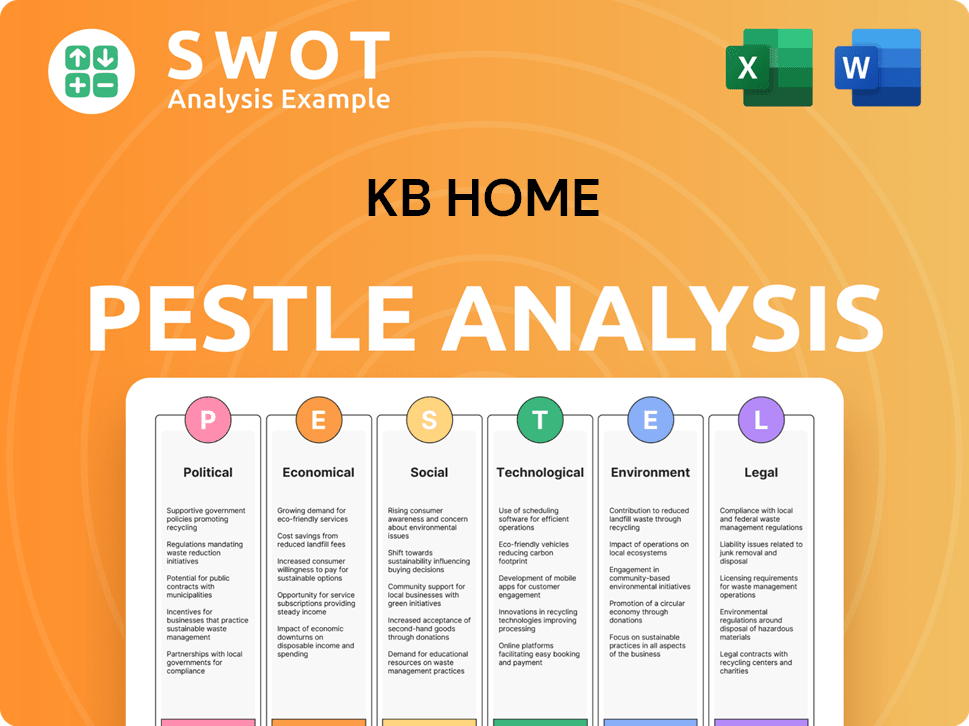
Who Sits on KB Home’s Board?
The current Board of Directors of KB Home oversees the company's governance and strategic direction. The board operates under a majority voting standard, with directors standing for election annually. All directors elected at the 2024 annual meeting attended the meeting. The company has a 'one-share-one-vote' structure, ensuring voting rights are proportional to economic interest. Understanding the structure of the board is key to grasping the dynamics of KB Home ownership.
The Board consists of individuals, some representing major shareholders and others holding independent seats. Approximately 90% of the directors are independent, and 50% are women or racial or ethnic minorities, promoting diversity. The average tenure of board members is about seven years, with five directors joining since 2021, indicating a refresh of the board. Only independent directors serve on Board committees. The company actively engages with its stockholders year-round on business strategy, performance, and outlook. Shareholders vote on board member appointees, with the governance and nomination committee overseeing the process.
| Board Member | Title | Tenure (Approximate) |
|---|---|---|
| Jeffrey T. Mezger | Chairman, President, and CEO | Since 2006 |
| M. David Paul | Lead Independent Director | Since 2014 |
| Other Directors | Various | Varies |
Shareholders were entitled to vote to elect ten directors for a one-year term at the 2025 Annual Meeting of Stockholders, scheduled for April 17, 2025, with the record date for stockholders being February 24, 2025. There is no public information suggesting recent proxy battles or governance controversies. For more insights into the company's approach, consider exploring the Marketing Strategy of KB Home.
The Board of Directors plays a vital role in KB Home's governance.
- Majority voting standard for director elections.
- Emphasis on independent directors and diversity.
- Active engagement with shareholders on strategic matters.
- Annual elections and a 'one-share-one-vote' structure.
KB Home Business Model Canvas
- Complete 9-Block Business Model Canvas
- Effortlessly Communicate Your Business Strategy
- Investor-Ready BMC Format
- 100% Editable and Customizable
- Clear and Structured Layout
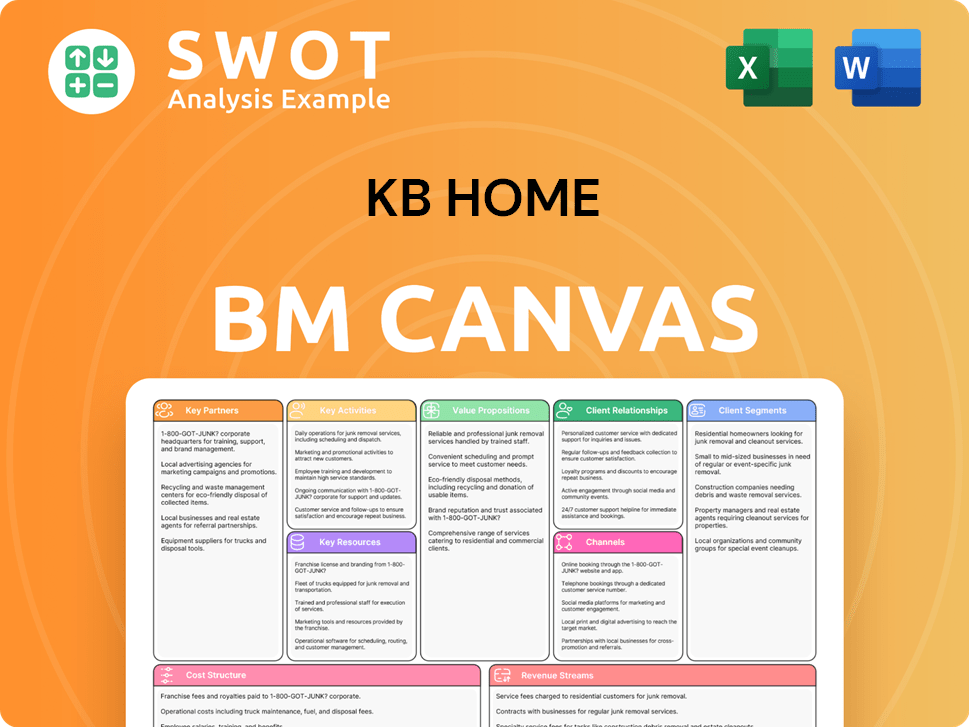
What Recent Changes Have Shaped KB Home’s Ownership Landscape?
In recent years, the company has maintained a balanced approach to capital allocation, focusing on both growth and shareholder returns. In 2024, the company returned over $420 million to its stockholders through share repurchases and quarterly cash dividends. This included repurchasing 6% of its outstanding shares at the start of the 2024 fiscal year. The company's investments in land acquisition and development increased by 58% to $2.84 billion in 2024, with plans to further increase this investment in 2025 to support future growth and community count.
Institutional ownership remains a key trend for the company. As of May 2025, institutional investors continue to hold a significant portion of the company's stock. For example, FMR LLC increased its ownership by 22.21% to 6,119,387 shares, representing 8.60% ownership as of May 12, 2025. BlackRock, Inc. decreased its holding by 17.47% to 8,825,772 shares, representing 12.40% ownership as of April 30, 2025. These shifts demonstrate active management of positions by large institutional funds, influencing the dynamics of Competitors Landscape of KB Home.
| Key Financial Metrics | 2024 | 2025 (Projected) |
|---|---|---|
| Diluted Earnings Per Share | $8.45 | N/A |
| Book Value Per Share | $56.27 (as of November 30, 2024) | N/A |
| Housing Revenues | N/A | $7.00 billion - $7.50 billion |
The company's diluted earnings per share rose by 20% to $8.45 in 2024, and its book value per share increased by 12% to $56.27 as of November 30, 2024. For the full year 2025, the company projects housing revenues in the range of $7.00 billion to $7.50 billion. The company's recent sustainability report, published in April 2025, highlights its leadership in energy efficiency, having built its 200,000th ENERGY STAR® certified home.
The company's stock performance is closely watched by investors. The share price and stock symbol are key indicators. Investors can find detailed information about the company's financial performance in its annual reports.
Understanding who owns the company is crucial for investors. Institutional investors hold a significant portion of the company's stock. Major shareholders include institutional investors such as FMR LLC and BlackRock, Inc.
The company's leadership team includes key executives. Information about the CEO and the board of directors can be found in the company's filings. The company's corporate structure and subsidiaries also play a role.
For further information, investors can contact the company's investor relations. The company's headquarters location is also a key detail. The company is publicly traded.
KB Home Porter's Five Forces Analysis
- Covers All 5 Competitive Forces in Detail
- Structured for Consultants, Students, and Founders
- 100% Editable in Microsoft Word & Excel
- Instant Digital Download – Use Immediately
- Compatible with Mac & PC – Fully Unlocked
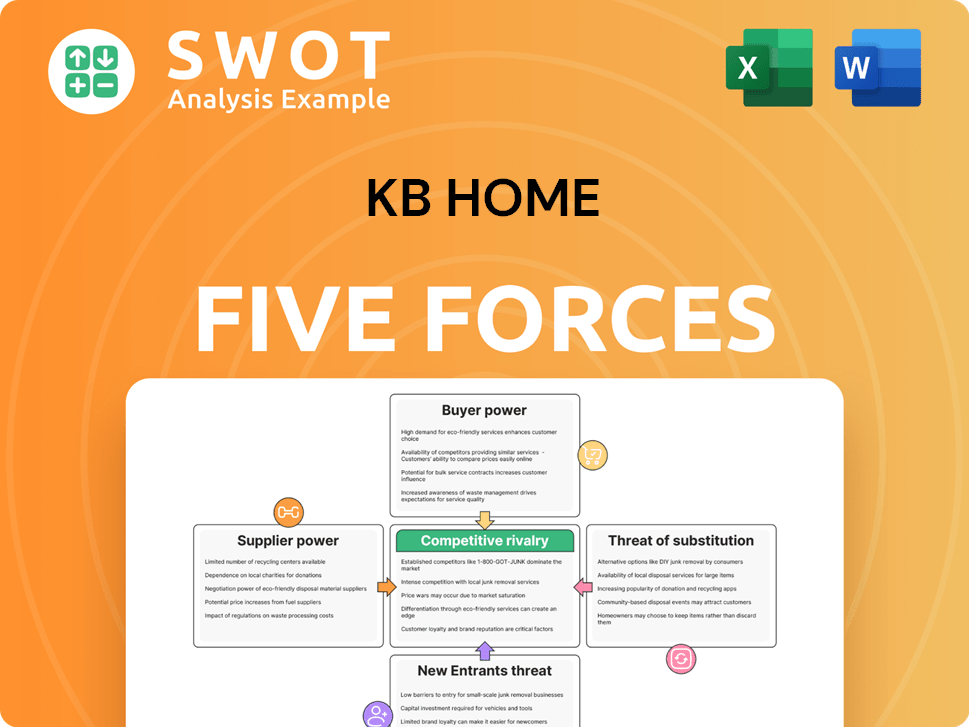
Related Blogs
- What are Mission Vision & Core Values of KB Home Company?
- What is Competitive Landscape of KB Home Company?
- What is Growth Strategy and Future Prospects of KB Home Company?
- How Does KB Home Company Work?
- What is Sales and Marketing Strategy of KB Home Company?
- What is Brief History of KB Home Company?
- What is Customer Demographics and Target Market of KB Home Company?
Disclaimer
All information, articles, and product details provided on this website are for general informational and educational purposes only. We do not claim any ownership over, nor do we intend to infringe upon, any trademarks, copyrights, logos, brand names, or other intellectual property mentioned or depicted on this site. Such intellectual property remains the property of its respective owners, and any references here are made solely for identification or informational purposes, without implying any affiliation, endorsement, or partnership.
We make no representations or warranties, express or implied, regarding the accuracy, completeness, or suitability of any content or products presented. Nothing on this website should be construed as legal, tax, investment, financial, medical, or other professional advice. In addition, no part of this site—including articles or product references—constitutes a solicitation, recommendation, endorsement, advertisement, or offer to buy or sell any securities, franchises, or other financial instruments, particularly in jurisdictions where such activity would be unlawful.
All content is of a general nature and may not address the specific circumstances of any individual or entity. It is not a substitute for professional advice or services. Any actions you take based on the information provided here are strictly at your own risk. You accept full responsibility for any decisions or outcomes arising from your use of this website and agree to release us from any liability in connection with your use of, or reliance upon, the content or products found herein.